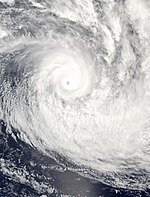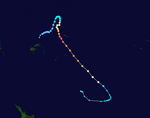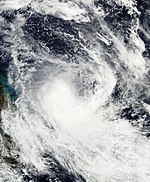2003–04 South Pacific cyclone season
| 2003–04 South Pacific cyclone season | |
|---|---|

Season summary map
|
|
| Seasonal boundaries | |
| First system formed | December 4, 2003 |
| Last system dissipated | April 24, 2004 |
| Strongest storm | |
| Name | Heta |
| • Maximum winds | 215 km/h (130 mph) (10-minute sustained) |
| • Lowest pressure | 915 hPa (mbar) |
| Seasonal statistics | |
| Total disturbances | 15 |
| Total depressions | 12 |
| Tropical cyclones | 3 |
| Severe tropical cyclones | 2 |
| Total fatalities | 16 |
| Total damage | $387 million (2004 USD) |
| Related articles | |
| Tropical disturbance (Australian scale) | |
| Duration | December 16 – December 20 |
|---|---|
| Peak intensity | Winds not specified 1002 hPa (mbar) |
| Category 5 severe tropical cyclone (Australian scale) | |
| Category 5 tropical cyclone (SSHWS) | |
| Duration | December 28 – January 7 |
|---|---|
| Peak intensity | 215 km/h (130 mph) (10-min) 915 hPa (mbar) |
| Category 4 severe tropical cyclone (Australian scale) | |
| Category 3 tropical cyclone (SSHWS) | |
| Duration | February 21 – February 28 |
|---|---|
| Peak intensity | 165 km/h (105 mph) (10-min) 935 hPa (mbar) |
| Category 2 tropical cyclone (Australian scale) | |
| Tropical storm (SSHWS) | |
| Duration | March 21 – March 23 |
|---|---|
| Peak intensity | 95 km/h (60 mph) (10-min) 985 hPa (mbar) |
| Tropical depression (Australian scale) | |
| Tropical storm (SSHWS) | |
| Duration | April 5 – April 9 |
|---|---|
| Peak intensity | 55 km/h (35 mph) (10-min) 995 hPa (mbar) |
The 2003–04 South Pacific cyclone season was a below-average season with only three tropical cyclones occurring within the South Pacific to the east of 160°E. The season officially ran from November 1, 2003 to April 30, 2004 with the first disturbance of the season forming on December 4 and the last disturbance dissipating on April 23. This is the period of the year when most tropical cyclones form within the South Pacific Ocean.
During the season at least 16 people were killed from tropical disturbances whilst overall damage was estimated at $218 million (2004 USD; $276 million 2017 USD). The most damaging tropical disturbance was Cyclone Heta which caused at least $211 million (2004 USD; $268 million 2017 USD) in damage to six different countries and left three dead. The deadliest tropical disturbance of the season was Tropical Depression 10F, which was responsible for eleven deaths and caused $2.74 million (2004 USD) in damage.Cyclone Ivy also caused 2 deaths and caused $4.17 million (2004 USD; $5.29 million 2017 USD) worth of damage to Vanuatu. As a result of the impacts caused by Heta and Ivy, the names were retired from the tropical cyclone naming lists.
Within the South Pacific, tropical cyclones are monitored by the Regional Specialized Meteorological Center (RSMC) in Nadi, Fiji, and the Tropical Cyclone Warning Center (TCWC) in Wellington, New Zealand. RSMC Nadi attaches a number and an F suffix to tropical disturbances that form in or move into the South Pacific. The United States Joint Typhoon Warning Center (JTWC) issues unofficial warnings within the South Pacific, designating tropical cyclones with a number and a P suffix. RSMC Nadi and TCWC Wellington both use the Australian Tropical Cyclone Intensity Scale, and measure windspeeds over a period of ten minutes, while the JTWC measures sustained winds over a period of one minute and uses the Saffir–Simpson Hurricane Scale.
...
Wikipedia









